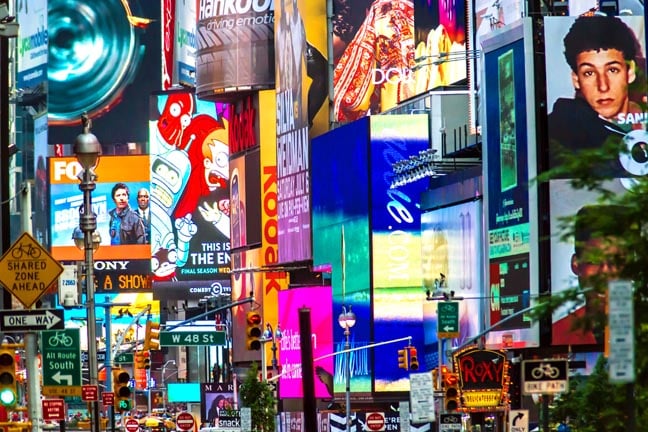
Amazon on Wednesday said its Amazon Ads customers can begin beta testing the deployment of AI-generated images for pitching products on its sales platform.
In so doing, Amazon follows the likes of Adobe, Google, Meta, and Microsoft, all of which now offer generative AI tools for crafting marketing messages. And it doesn’t seem Amazon has used that extra time to great effect.
The image generation capabilities available to Amazon Ads clients are fairly limited at this point. Amazon describes its service as “a generative AI solution designed to remove creative barriers and enable brands to produce lifestyle imagery that helps improve their ads’ performance.”
That makes it sound as if ad copywriters and designers regularly stare at their screens, unable to come up with compelling text and images that move merchandise. Maybe so. Amazon insists that it conducted a survey that found among those unable to create successful ad campaigns, 75 percent cited building creative material and formatting as the major obstacle.
But what Amazon is offering isn’t a soup-to-nuts creative suite. Rather, it’s a modest background generator in which context-free product images can be overlaid atop a computer-conceived kitchen or similar model-spawned environment. It also handles simple, but tedious., tasks like generating multiple image sizes – a feature in many traditional image processing apps.
“For example, an advertiser may have standalone images of their product against a white background, like a toaster,” Amazon’s post proposes. “When that same toaster is placed in a lifestyle context—on a kitchen counter, next to a croissant—in a mobile Sponsored Brands ad, click-through rates can be 40 percent higher compared to ads with standard product images.”
Who knew that mixing isolated toaster images with kitchen counters and croissants would result in a better performing ad? Every ad agency ever? Well, you can’t rely on an external agency to say such things when you’re designing your own marketing on the cheap via Amazon Ads.
And that’s the audience Amazon is aiming at, “those that do not have in-house capabilities or agency support” – though the biz suggests bigger brands too may want to use a tool that requires “no technical expertise.” It’s not as if advertising is so important that you’d want to involve a professional.
Amazon’s decision to limit its generative AI to image backdrops looks like a reasonable way to avoid the potential problems with machine-generated text – something several publications have learned the hard way. We note that the theme menu – by which images can be redecorated to reflect a selected topic – is sensibly constrained. There’s a “Pumpkin spice” option, for adding festive gourds beside one’s toaster, but no potentially controversial click-bait settings like “dive bar” or “edgelord orgy.”
Marketers deploying algorithmically conjured ads may find it worthwhile to heed the US Federal Trade Commission’s warning earlier this year about AI output that’s biased or discriminatory, or makes inaccurate claims.
But the Feds may have trouble keeping tabs on such stuff. According to a University of Kansas study earlier this year, only about half of AI-generated ads online are labeled as such. Commercial schemes it watermark AI content by Microsoft, Adobe, and others, also look rather ineffective.
There’s not much public data on the effectiveness of AI-generated ads, which are still a relatively new phenomenon. Google, not exactly a disinterested party when it comes to the subject, claims that its AI-based Performance Max campaigns “achieve on average over 18 percent more conversions at a similar cost per action.”
However, earlier this year, Borzo, a courier service based in India, reportedly found that human-designed ads were more effective and less expensive than AI-generated ads at customer acquisition.
The battle between human and computer relativity goes on. ®
- SEO Powered Content & PR Distribution. Get Amplified Today.
- PlatoData.Network Vertical Generative Ai. Empower Yourself. Access Here.
- PlatoAiStream. Web3 Intelligence. Knowledge Amplified. Access Here.
- PlatoESG. Carbon, CleanTech, Energy, Environment, Solar, Waste Management. Access Here.
- PlatoHealth. Biotech and Clinical Trials Intelligence. Access Here.
- Source: https://go.theregister.com/feed/www.theregister.com/2023/10/26/amazon_ads_generative_ai/
- :has
- :is
- :not
- $UP
- 40
- 7
- 75
- a
- About
- According
- Achieve
- acquisition
- Action
- Ad
- adding
- Adobe
- Ads
- Advertising
- against
- agency
- AI
- Aiming
- algorithmically
- All
- also
- Amazon
- among
- an
- and
- apps
- ARE
- AS
- At
- audience
- available
- average
- avoid
- backdrops
- background
- bar
- barriers
- based
- Battle
- BE
- begin
- beta
- Better
- between
- biased
- bigger
- biz
- brands
- Building
- but
- by
- Campaigns
- CAN
- capabilities
- cheap
- cited
- claims
- clients
- CO
- come
- comes
- commercial
- commission
- compared
- compelling
- composition
- computer
- conducted
- controversial
- conversions
- Cost
- Counter
- counters
- create
- Creative
- customer
- Customers
- data
- decision
- deploying
- deployment
- designed
- designers
- designing
- dive
- do
- doesn
- doing
- Earlier
- effect
- Effective
- effectiveness
- enable
- Environment
- EVER
- Every
- exactly
- example
- expensive
- expertise
- external
- extra
- fairly
- Feature
- Federal
- Federal Trade Commission
- Feds
- Find
- follows
- For
- found
- FTC
- generating
- generation
- generative
- Generative AI
- generator
- Goes
- great
- Half
- Handles
- Hard
- Have
- helps
- higher
- HTTPS
- human
- if
- image
- images
- important
- improve
- in
- inaccurate
- india
- involve
- isn
- isolated
- IT
- ITS
- jpg
- Kansas
- keeping
- learned
- less
- lifestyle
- like
- likes
- LIMIT
- Limited
- Look
- LOOKS
- major
- MAKES
- many
- Marketing
- material
- May..
- maybe
- Menu
- merchandise
- messages
- Microsoft
- Mixing
- Mobile
- modest
- more
- move
- much
- multiple
- New
- next
- no
- now
- obstacle
- of
- offer
- offering
- on
- ONE
- online
- only
- Option
- or
- Others
- out
- output
- over
- own
- party
- per
- percent
- performance
- performing
- phenomenon
- pitching
- platform
- plato
- Plato Data Intelligence
- PlatoData
- Point
- potential
- potentially
- problems
- processing
- produce
- Product
- Products
- professional
- proposes
- public
- Rates
- rather
- RE
- reasonable
- reflect
- regularly
- relatively
- relativity
- rely
- remove
- requires
- result
- rolls
- s
- Said
- sales
- same
- say
- schemes
- screens
- seem
- selected
- service
- settings
- similar
- Simple
- sizes
- So
- solution
- something
- Sound
- spice
- Sponsored
- standalone
- standard
- Still
- subject
- successful
- such
- Suggests
- suite
- support
- Survey
- tasks
- Technical
- Testing
- text
- than
- that
- The
- their
- theme
- There.
- things
- this
- this year
- those
- though?
- time
- to
- too
- tool
- tools
- topic
- trade
- traditional
- trouble
- unable
- university
- us
- US Federal
- us federal trade commission
- use
- used
- via
- want
- Way..
- we
- Wednesday
- WELL
- were
- What
- when
- which
- white
- with
- worthwhile
- would
- year
- You
- Your
- youtube
- zephyrnet













